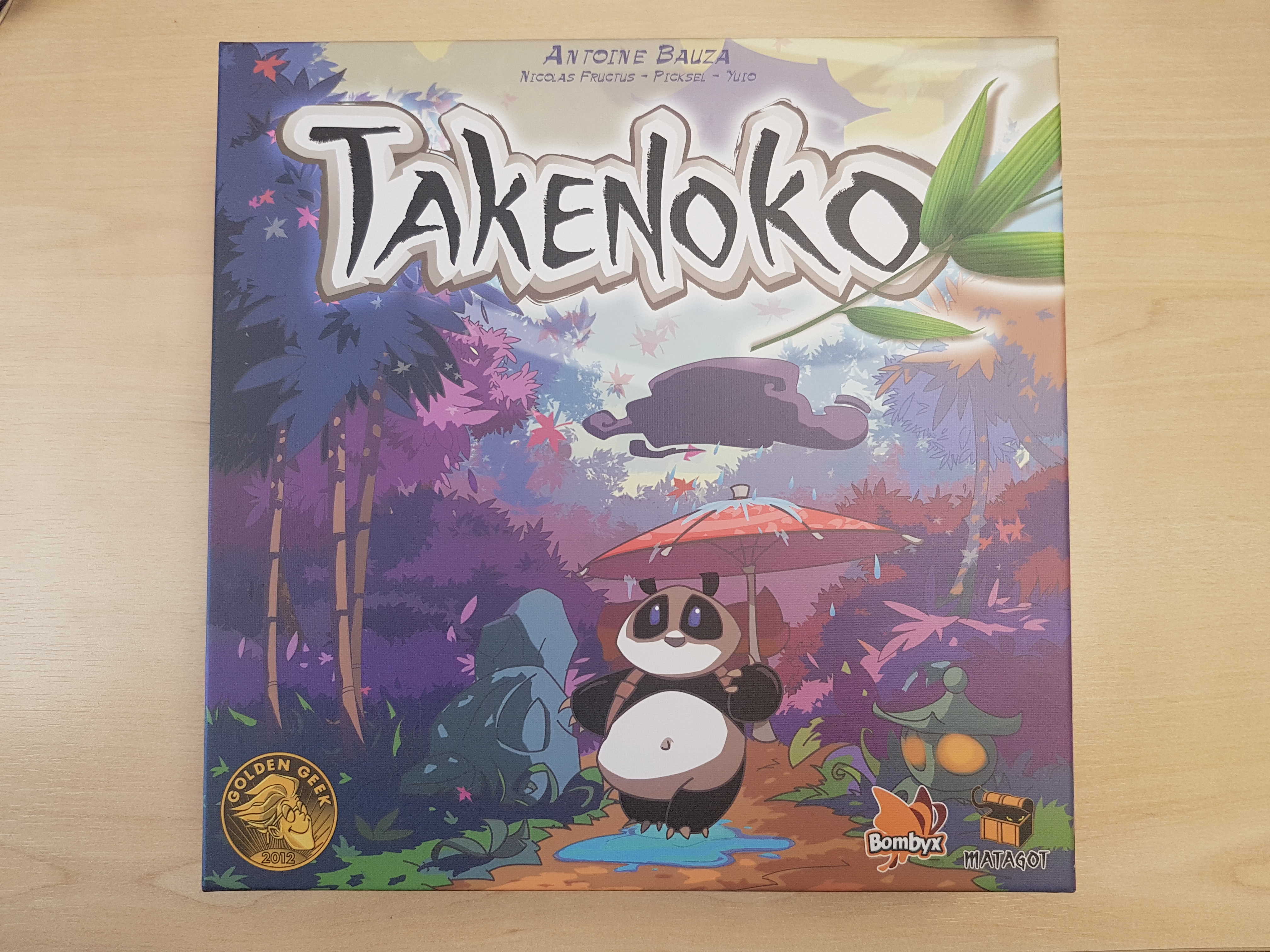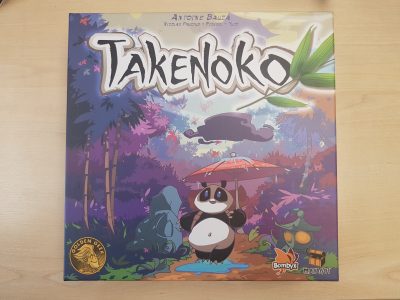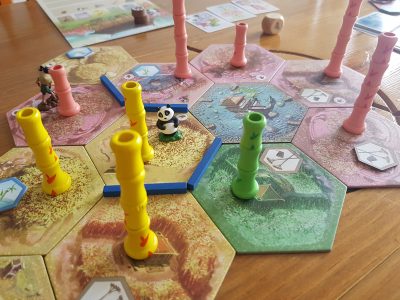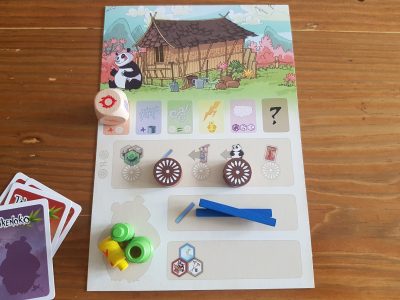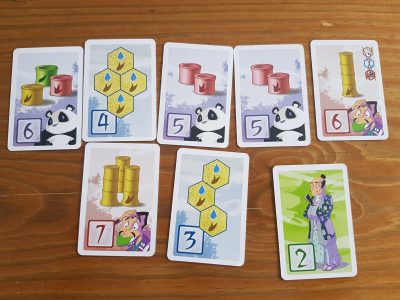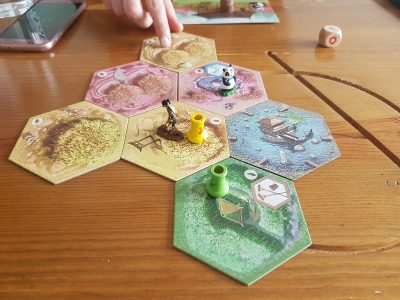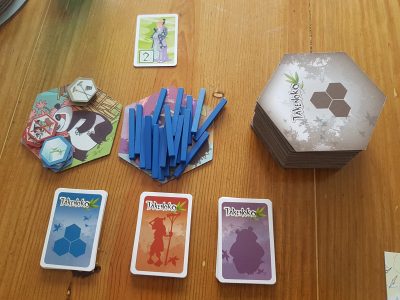Takenoko is a panda and bamboo themed tile placement game for 2 – 4 players. Each player takes up the role of a courtesan of the Nippon Emperor. This puts them in charge of tending to the Emperor’s bamboo garden and the symbol of peace from the Chinese Emperor, a giant panda. Players must balance the hunger of the panda with growing a wonderful bamboo garden, something which is not always easy to balance! How do players go about doing this? Let’s find out!
Players have 5 actions available to them on their turn, of which by default they can choose two different actions. These can all help towards objective that score players points. These include moving the panda or gardener, taking tiles, irrigation sticks or new objective cards. Players can move the panda or gardener in straight lines off the edges of the hex they start on. When the panda reaches a square, if possible and in the absence of an Enclosure symbol, the panda eats one piece of bamboo. Here the player takes the top most piece and adds it to his/her player mat. If the gardener lands on an irrigated tile on that hex and every irrigated adjacent identical coloured hex bamboo grows, up to a maximum height of 4 pieces.
As player take tiles they take the top 3 from the tile deck. Choosing one to place down, the map expands, while the other two are returned to the bottom of the draw deck. These new tiles, unless coming with their own water source, need water before anything can grow on them. This is where the irrigation sticks come into play. When taking this action the player claims a stick and places it into his/her stash. At any point on that turn of subsequent turns as a free action players can place an unlimited number of irrigation sticks along the edges of tiles to get the water flowing. Finally are objective cards. Players need to score points at the end of the day and getting new objectives helps to widen the variety of ways to gain points!
After each player has had their first turn the weather die comes into play. This does slightly add an element of luck and randomness to the game but by no means can it win or lose a game any more than picking up “bad” objective cards. One way that this could be avoided is if the starting player rolls for all players so everyone gets the same ability for that round. Either way I feel like the randomness just slightly lets Takenoko down.
The die can give players an extra action, the ability to do the same action twice, move the panda to any tile and eat a single piece of bamboo, make it rain on one irrigated tile to grow it by 1 bamboo piece or take an Improvement Chip. The sixth side of the dice is a “?” and allows the player the choice of which Weather ability they want to use. Extra action is often considered the best but all abilities can be helpful at specific times. Due to this it is best to have a range of objective cards. Getting the full hand of 7 objectives maximises the chances of the weather die helping but means players will have spent a lot of actions beforehand to obtain the cards.
Takenoko isn’t over when a pre-defined score is reached. Instead, when a player has a determined number of completed objective cards. As soon as the first player has reached this completed count they are awarded a bonus 2 points from the Emperor card, scores are calculated and the best bamboo-er is crowned. Note, that the objective cards vary in difficulty and points awarded. This can see players with fewer cards winning overall.
There is a common theme to starting turns as players look to add tiles to the expanding game board and pick up additional objectives cards. These actions are beneficial on two counts at the start of the game as you can start to see the amount of different coloured tiles available to grow on and then target specific objectives from a bigger selection. A few turns in and players start to go off in differing directions and the actions become more varied. Some will need irrigation sticks to get water to newly placed tiles to irrigate a specific pattern of tiles. Others will be moving the gardener and panda around to get some colourful bamboo onto their player mat for the rather hungry panda objectives.
Rolling the die and getting the cloud symbol nets you an Improvement Chip. These tokens can be extremely helpful for getting objective cards completed. Alternatively, they can be used to throw a bamboo crafted spanner into opponents plans. For example, if you need to irrigate a tile to complete an objective card placing the watershed chip instantly makes it count as an irrigated tile. The second of the tokens, Fertilizer, is for double growth. As long as the tile is irrigated when bamboo growth there two pieces are added at once. The third and final is Enclosure; which as mentioned above stops the panda from eating on that tile. This is great if you notice an opponent eating up a specific colour to block a potential coloured food source. The improvement chips have the potential to be very powerful, thankfully to balance them individual tiles can only have one type of upgrade.
There are three types of objective cards to choose from: Plots, Gardener and Panda. Having these different types of objective means that players can mix and match as they see fit. Often, you’ll find you have a preference of objective but this can change from game to game. Most importantly when taking these is to keep them hidden from opponents. At times you can be fortunate enough to have other players finishing plot objectives for you: placing the perfect pattern of tiles and irrigating them for their own personal objectives.
One aspect that Takenoko partially takes from other tile placements is the irrigation system. Like the roads in Settlers of Catan players must build streams down the edges of the tiles. If the tile touches the starting water temple tile it has ample water supply. As soon as a tile is placed not adjacent to the water temple then it needs a water supply. This means players will have to save up the blue wooden stick-like irrigation tokens, to create a waterway from the starting tile to the destination or another pre-created waterway. Some players will strive to get these onto the board as soon as possible but sometimes holding onto them can be beneficial.
Cute and stunning are the unusual mix of words best suited to describe the art style and theming of Takenoko. The elements which involve the panda have a cuteness to them that shines through with the bright colours used to create an almost happy, fun appeal. The individual hexagon tiles which creates the game board then feature stunning illustrations of bamboo fields, the central starting palace and more. This theming full of vibrancy filters across to the player mats which continue the strong Japanese, bamboo, panda theme. Even down to the unique action markers for each player.
Takenoko is designed for 2 – 4 players. 2 is good but the entertainment provided seems to ramp up as the player count raises from lowest to max. If someone was to want to play a two-player game I would be more than up for it. The rules and gameplay work perfectly with two. That being said, the game board grows and evolves faster with additional players. More happens between your turns, with the springing up of bamboo shoots and potentially multiple new tiles being laid down before you get another turn. Some will naturally enjoy the more planning and blocking gameplay possible in a 1 vs 1 game. This doesn’t completely disappear but it is adapted when there are more players to interrupt your plans.
Takenoko is mechanically a very solid game, even with the luck aspect of the die roll. What will undoubtedly catch people’s attention and hearts is the theme the game is built around. The cute panda, the colourful bamboo and gorgeous tiles all work together harmoniously to create a visual treat that spreads across the table. Who can say no to such an awesomely themed game? Let alone one that is fun to play over and over again. Takenoko hasn’t just earnt its place on my gaming shelf its design has completely won me over. Does it hit the heights of my top 10… no quite but it certainly was knocking on the door!
[Editor’s Note: Takenoko was provided to us by Esdevium Games for review purposes. The game is currently available on 365 Games for £25.99. It is also available from local UK board game stores, find your local store here]

